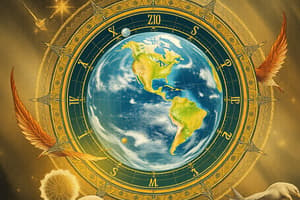Podcast
Questions and Answers
What are the two large-scale motions of the Earth in its movement through space?
What are the two large-scale motions of the Earth in its movement through space?
The two large-scale motions are the movement of the Earth along with the Solar System and the revolution of the Solar System around the center of the Milky Way galaxy.
Define rotation and explain its significance to the Earth's day-night cycle.
Define rotation and explain its significance to the Earth's day-night cycle.
Rotation is the spinning of the Earth on its axis from west to east, which creates the cycle of day and night.
How long does one complete rotation of the Earth take in terms of a sidereal day?
How long does one complete rotation of the Earth take in terms of a sidereal day?
One complete rotation, known as a sidereal day, takes 23 hours, 56 minutes, and 4 seconds.
Describe the relationship between revolution and the calendar year.
Describe the relationship between revolution and the calendar year.
What is the duration of one complete revolution of the Earth referred to as, and how long does it take?
What is the duration of one complete revolution of the Earth referred to as, and how long does it take?
Explain the term 'ecliptic plane' and its significance to the Earth's orbit.
Explain the term 'ecliptic plane' and its significance to the Earth's orbit.
Identify the three key locations defined by the Earth's rotation.
Identify the three key locations defined by the Earth's rotation.
What effect does the tilt of the Earth's axis have on seasonal changes?
What effect does the tilt of the Earth's axis have on seasonal changes?
What is the difference between a solar day and a sidereal day?
What is the difference between a solar day and a sidereal day?
Why does the calendar year include leap years, and how often do they occur?
Why does the calendar year include leap years, and how often do they occur?
Flashcards
Earth's rotation
Earth's rotation
The spinning of Earth on its axis from west to east.
Earth's revolution
Earth's revolution
Earth's movement around the Sun.
Rotation - sidereal day
Rotation - sidereal day
The time it takes Earth to complete one full rotation, relative to the stars.
Rotation - solar day
Rotation - solar day
Signup and view all the flashcards
Revolution - tropical year
Revolution - tropical year
Signup and view all the flashcards
Ecliptic Plane
Ecliptic Plane
Signup and view all the flashcards
Leap year
Leap year
Signup and view all the flashcards
Axis
Axis
Signup and view all the flashcards
Equator
Equator
Signup and view all the flashcards
North Pole
North Pole
Signup and view all the flashcards
Study Notes
Planetary Motions
- Earth experiences various motions, differing in magnitude.
- Motions categorized into large-scale and small-scale.
Large-Scale Motions
- Largest motion: Earth's movement with the rest of the Solar System and galaxy.
- Second largest motion: Revolution of the Solar System around the center of the Milky Way galaxy.
Small-Scale Motions
- Responsible for changes in Earth's position relative to the Sun.
- Cause the changing seasons and the alternation of day and night.
- Basis for our system of keeping time
- These include rotation and revolution.
Rotation
- Spinning motion of Earth from west to east.
- Defines important locations: North Pole, South Pole, and Equator.
- One complete rotation (sidereal day): 23 hours, 56 minutes, and 4 seconds.
- Time-measuring unit (solar day): 24 hours.
Revolution
- Earth revolves around the Sun.
- Revolution period (tropical year): 365 days, 5 hours, 49 minutes.
- Calendar years are typically 365 days long.
- Leap years (every 4 years) include an extra day (February 29) to account for the extra time.
- Revolution occurs on a plane called the ecliptic, in the same direction as other planets.
- Earth's axis is tilted at 23.5° from the perpendicular to the plane of its orbit (ecliptic).
Studying That Suits You
Use AI to generate personalized quizzes and flashcards to suit your learning preferences.




